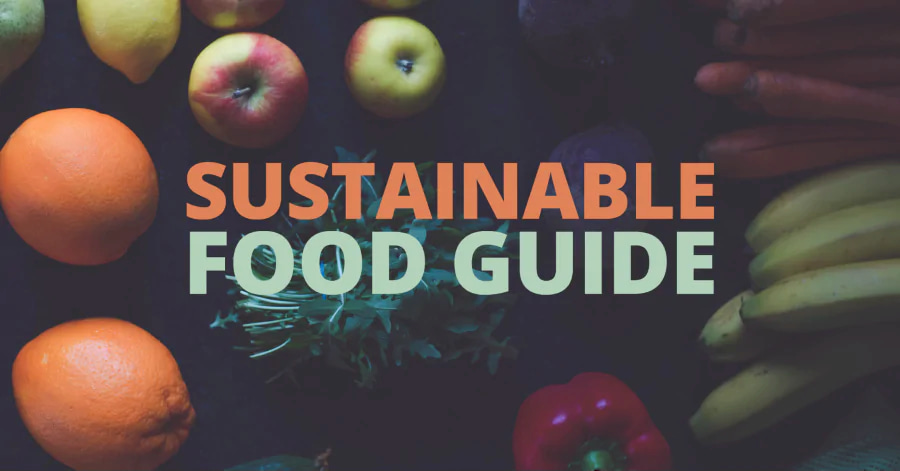
Sustainable Food Guide
‘Living sustainably’ is a phrase we have all become quite familiar with in 2020. But what does it actually mean to put this into practice?
Although sustainability is not a new concept, it has recently taken centre stage through social movements such as the ‘School Strike for Climate’ initiative with Greta Thunberg. Embracing a sustainable way of life not only benefits your health; it can also have a positive impact on animals, the environment and our planet.
But to make the transition to living and eating more sustainably, we first need to understand exactly what sustainability means.
In this short guide, we’ll cover all you need to know about sustainability and sustainable food choices, and how you can make smart decisions to reduce your environmental footprint.
What is sustainability?
Sustainability has been defined in many different ways by many different people. But is best described as the ability of biological systems to remain healthy, diverse and productive over time. Living sustainability is about meeting the needs of ‘now’ without compromising the ability of future generations to do the same.
Sustainable eating is one of the areas where we can make the most impact as individuals. Sustainable foods are produced in a way that’s beneficial for the environment and humane to farmers, workers, and animals alike.
Sustainable food production is vital for our planet and no less important for our health. Opting for sustainable foods wherever possible can help minimise greenhouse gas emissions. It can also contribute to decreased food waste and reduced exposure to the harmful chemicals, additives and preservatives that abound throughout the standard food supply chain.
1. Eat mostly plants
Whether you go full vegan, weekday vegetarian or even just practice meat-free Mondays, every step you take in the direction of a more plant-centric diet is a worthy one for both you and the environment (1).
According to the UN, removing meat and dairy products from your diet is the most significant thing you can do to reduce your environmental impact, due to the damage farming does to the planet (2).
With farm animals and animal production facilities covering one-third of the planet’s surface (3), loss of wild areas to agriculture is the leading cause of today’s mass wildlife extinction.
Meat and dairy products, and especially beef production, provide just 18% of the calories humans consume but use 83% of farmland. Meanwhile, meat and dairy production, especially beef, is responsible for 60% of agriculture-related greenhouse gas emissions. And that’s not all: rearing and transporting livestock also requires more food, water, land, and energy than plants (1).
As the number of farm animals reared for meat, egg, and dairy products increases, so do the emissions generated by their production. Most concerning of all, it is predicted that global farm animal production will double from present levels by 2050. What’s more, the majority of this production will take place through environmentally and nutritionally damaging intensive farming methods (3).
To eat for our own health and that of the planet, we should consider picking non-meat proteins as our main protein sources such as nuts, seeds and legumes. To begin cutting down on meat and dairy consumption, start by cutting it out on certain days of the week and from there you can limit it further as you see fit.
2. Vary your seafood
According to the World Wildlife Foundation (WWF), the UK consumes nearly £5 billion worth of seafood yearly (5). High demand and mismanagement has resulted in overfishing, leaving numbers of certain varieties, including cod and wild Atlantic salmon, to plummet (6) (7). As highlighted by the Food and Agriculture Organization (FAO), the frustration with the fishing industry is that 35% of all fish that are caught and killed are bycatch; either caught in old or discarded fishing nets, or too small or unpopular for commercial use and just disposed of needlessly (8).
When shopping, choose products with labels such as the blue MSC label, which verify that the fish comes from a well-managed source. And try to opt for lesser-known species like pollock and hake, or fish further down the food chain such as sardines.
3. Eat locally
Shopping locally is a key part of sustainable eating and can make a big impact. According to Rich Pirog of the Leopold Center for Sustainable Agriculture, the average fresh food item travels 1,500 miles to reach our plates (9). That’s a pretty large carbon footprint to leave for a bulb of garlic.
Buying your food from local sources eliminates the need for fuel-intensive transportation and helps cut down the greenhouse gas emissions associated with importing produce. Where possible, select farmers who follow sustainable farming practices to minimise the environmental impact of your food.
4. Say no to palm oil (for now)
Unsustainable palm oil (which is the vast majority of palm oil) is responsible for large-scale deforestation, putting wildlife like orangutans under threat (10). This often-harmful product also contributes to greenhouse gas emissions and climate change (11).
But rejecting palm oil all together might potentially have even worse consequences. Indeed, many commonly offered alternatives can be even more damaging for the environment, with some requiring up to nine times as much land to produce. And from a health perspective, palm oil is a good substitute for hydrogenated oils; the ‘trans fats’ loved by food processors and despised by health advocates.
So, as you can see it is not a straightforward topic. The positive news here is that big food companies and environmental NGOs are keenly aware of this current issue. They are working towards a plan that – hopefully in the near future – will see palm oil growers plant on already-deforested land, thereby not contributing to further deforestation. In the meantime, avoid palm oil where you can and keep your ears open for progress in the fight for sustainable palm oil.
5. Get gardening
The most sustainable option of all? Become self-sufficient! Venturing into the world of gardening is a great way to add more fresh produce to your meals while also having a positive impact on the environment and supporting sustainable agriculture. According to The Allotment Garden, produce that is easy grown in the UK includes lettuce, quinoa, French beans, peas, mangetout, sweetcorn, spring onion, radish, carrots, beetroot and asparagus (12).
Sustainability is not always at the forefront of our minds as we do our weekly food shop and certainly is overlooked when considering what a healthy diet should look like. However, sustainable foods are important for our health, our communities and the planet we inhabit. Opting for sustainable food choices and making a few minor adjustments to your shopping list can ensure that you’re eating ethically and responsibly to preserve the health of the planet for generations to come.
References:
1. E., Harris, F., Dangour, A.D., Gasparatos, A., Hiramatsu, M., Javadi, F., Loken, B., Murakami, T., Scheelbeek, P. and Haines, A. (2018b). Sustainable food systems—a health perspective. Sustainability Science, 13(6), [online] pp.1505–1517. Available at: https://www.ncbi.nlm.nih.gov/pmc/articles/PMC6267166/Lindgren [Accessed 25 Aug. 2020]
2. Ipcc.ch. (2019). Special Report on Climate Change and Land — IPCC site. [online]. Available at: https://www.ipcc.ch/srccl/ [Accessed 25 Aug. 2020]
3. Koneswaran, G. and Nierenberg, D. (2008). Global Farm Animal Production and Global Warming: Impacting and Mitigating Climate Change. Environmental Health Perspectives, [online] 116(5), pp.578–582. Available at: https://pmc.ncbi.nlm.nih.gov/articles/PMC2367646/ [Accessed 24 Aug. 2020]
4. NPR.org. (2012). A Nation Of Meat Eaters: See How It All Adds Up. [online] Available at: https://www.npr.org/sections/thesalt/2012/06/27/155527365/visualizing-a-nation-of-meat-eaters?t=1619433414891 [Accessed 27 Aug. 2020]
5. WWF. (n.d.). Sky Ocean Hero. [online] Available at: https://www.wwf.org.uk/ocean-heroes [Accessed 25 Aug. 2020].
6. Boonstra, W.J. and Österblom, H. (2014). A chain of fools: or, why it is so hard to stop overfishing. Maritime Studies, [online]13(1). Available at: https://link.springer.com/article/10.1186/s40152-014-0015-4 [Accessed 24 Aug. 2020]
7. Pandolfi, J. (2009). Evolutionary impacts of fishing: overfishing’s “Darwinian debt.” F1000 Biology Reports, [online] 1. Available at: https://pmc.ncbi.nlm.nih.gov/articles/PMC2924707/ [Accessed 24 Aug. 2020]
8. fao.org (2018). SOFIA 2018 – State of Fisheries and Aquaculture in the world 2018. [online] www.fao.org. Available at: http://www.fao.org/state-of-fisheries-aquaculture/en/ [Accessed 26 Aug. 2020]
9. Pirog, R. and Benjamin, A. (2003). Checking the Food Odometer: Comparing Food Miles for Local versus Conventional Produce Sales to Iowa Institutions Part of the Bioresource and Agricultural Engineering Commons, Horticulture Commons, and the Operations and Supply Chain Management Commons. [online] Available at: https://pdfs.semanticscholar.org/4396/7f343d47bdcb3e18b1b3d661987e8787aea9.pdf [Accessed 3 Jul. 2020]
10. Meijaard, E., Buchori, D., Hadiprakarsa, Y., Utami-Atmoko, S.S., Nurcahyo, A., Tjiu, A., Prasetyo, D., Nardiyono, Christie, L., Ancrenaz, M., Abadi, F., Antoni, I.N.G., Armayadi, D., Dinato, A., Ella, Gumelar, P., Indrawan, T.P., Kussaritano, Munajat, C., Priyono, C.W.P., Purwanto, Y., Puspitasari, D., Putra, M.S.W., Rahmat, A., Ramadani, H., Sammy, J., Siswanto, D., Syamsuri, M., Andayani, N., Wu, H., Wells, J.A. and Mengersen, K. (2011). Quantifying Killing of Orangutans and Human-Orangutan Conflict in Kalimantan, Indonesia. PLoS ONE, [online] 6(11), p.e27491. Available at: https://pmc.ncbi.nlm.nih.gov/articles/PMC3214049/ [Accessed 26 Aug. 2020]
11. Kadandale, S., Marten, R. and Smith, R. (2018). The palm oil industry and noncommunicable diseases. Bulletin of the World Health Organization, [online] 97(2), pp.118–128. Available at: https://www.who.int/bulletin/volumes/97/2/18-220434/en/ [Accessed 26 Aug 2020]
12. The Allotment Garden – Organic Gardening. (2009). Easy vegetables to grow in the UK – A beginners guide. [online] Available at: https://www.theallotmentgarden.co.uk/easy-grow/ [Accessed 26 Aug. 2020]


